Escape to Safi, the town of potters
17 March, 2008, 08:50 am in "Morocco"
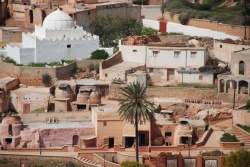 After being awakened at midnight by a tour group of about 20 very vocal young people, we realized that we were not going to be able to relax in Marrakesh. Awakened by the group, we were out of the hotel by 7 AM, and soon were waiting for the train to Safi, a town we heard was a beach town, non-touristy, and a big ceramics center.
After being awakened at midnight by a tour group of about 20 very vocal young people, we realized that we were not going to be able to relax in Marrakesh. Awakened by the group, we were out of the hotel by 7 AM, and soon were waiting for the train to Safi, a town we heard was a beach town, non-touristy, and a big ceramics center.We arrived around 2 PM and checked into a hotel, passing up the ocean view rooms which were above a noisy street, for a quiet one on the side.
Although Safi is a town with a beach, it isn't a resort town. The beach is a working port dominated by a phosphate plant.
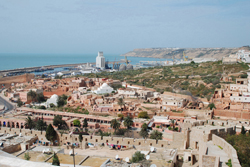
The Medina has graceful stone walls, towers, and gates and is crowned by a white washed Portuguese fort.
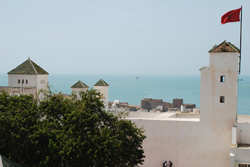
It took us about 5 minutes to walk across the Medina past rows of shops selling everyday items; clothing, shoes and toiletries. Towards the end there was a ceramics market but aside from that there were no tourist items for sale. Only one shop keeper tried to get us to visit his clothing shop.
As we reached the gate to the area outside the Medina, we noticed several kilns rising above small walls. Even though we were looking for a place to eat lunch, Rowshan couldn't resist walking into one of the workshops to watch a man loading a kiln. Inside we were shown piles of ceramic drums ranging from a couple inches to a more practical drum size.
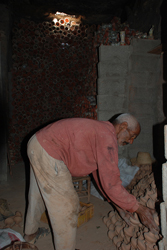
As we left a young man asked us to visit his workshop but we said first we needed to eat lunch. He led us past some ceramics shops to a small restaurant with no name.
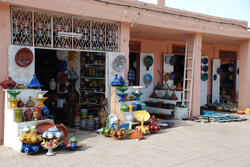
The friendly owner, Hosny, opened several tagine dishes revealing the items on the menu and telling us the prices. We settled on a large chicken tagine to share and a salad. Hosny told us how the tagines (ceramic dishes) used for cooking tagines (the food name) were made near Marrakesh because they needed to be made from a certain type of clay that wouldn't crack when heated.
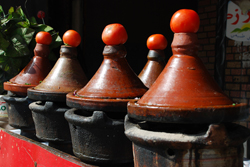
This fact, however, does not stop the potters of Safi from making plenty of decorative tagine dishes which can be used for serving tagines. Our chicken tagine was delicious with nicely caramelized bits on the bottom of the dish.
We started to walk to the center of town but once again Rowshan was drawn to the kilns. A man was feeding branches into a fiery kiln.
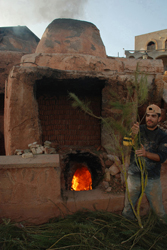
As we were watching, a young man in a Barcelona shirt came from a shop next to the kiln and started talking to us. He also worked in one of the ceramics factories decorating the dishes. This work involved cutting flower and other design patterns into plates and other objects, using a sharp tool, before the pieces were fired. He took us to one of the workshops. Two men were busy making plates and ashtrays using kick wheels. One dipped the pieces in a white base coat and another was wedging clay.
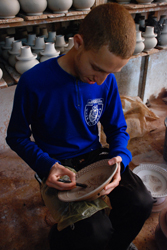
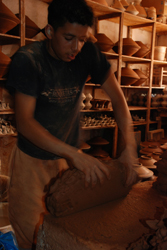
They liked Rowshan's photos of his drums. Then we went to the shop where our new friend, Azzedine, worked and he showed us some of the pieces he had made as well as introduced us to the other decorators in the workshop.
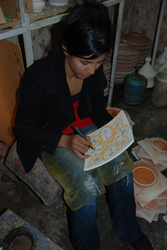
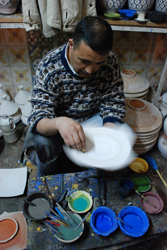
Since communication was a little difficult (Azzedine spoke some French but my French is really minimal) he called in his friend Hameda who spoke some English. We discussed the possibility of Rowshan coming and studying for a month and then went over to a teacher's workshop. Abdelhah was sitting at a wheel in a tiny workshop decorated with certificates showing he had conducted workshops in various locations around the world.
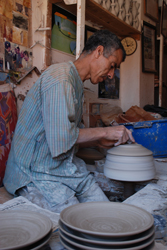
He showed us a folder filled with student references and comments.
Next we went to another workshop where we watched more decorators as well as men loading a large gas kiln.
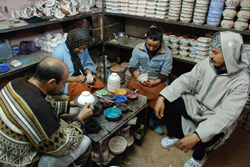
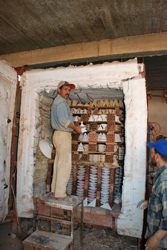
Then we walked past the blazing kilns to Azzedine's shop where we had tea.
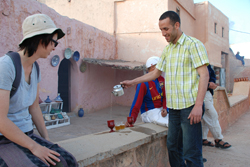
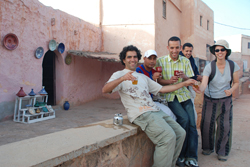
It was a really pleasant afternoon and we chatted about this and that. Then we bid them farewell and went for a walk up the hill to the new town to see the giant tagine dish which was the symbol of the town. Azzedine had a postcard in his shop showing that at one point a giant tagine was cooked in the giant tagine dish which was made out of concrete and not clay.
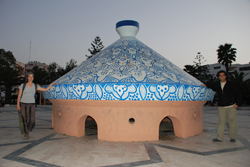
We walked alongside the outside of the Medina wall and were able to see the sun beginning to set over the Atlantic.
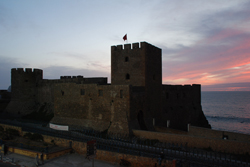
Rowshan scored a goal through one of the city gates as we walked by some kids playing soccer. When the goal keeper asked Rowshan for money, Rowshan replied that he was Maradona (since lots of people think Rowshan is Argentinian) which made the kid stare at him for a moment then run away.
I always say the difficult and wonderful thing about travel is the crazy ups and downs. One moment you are ecstatic and in love with a place and the next you are cursing it and everyone who lives there... only to find yourself a moment later considering moving there.
We had a day like that. We started out with breakfast at a cafe and some Internet time.... well actually we started out by sleeping in since it was the first good night's sleep we'd had in a long time. The Majestic Hotel is the first place we've slept in, in Morocco, with soft pillows.
Next we walked to the Portuguese fortress which houses the National Museum of Ceramics. It contained fragments of ancient ceramics as well as Islamic pieces and rooms devoted to Fes, Meknes, and Safi designs.
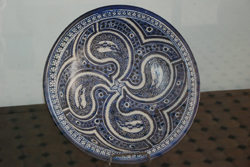
The guy working there had explained that after we finished looking at the collection we could go up on the ramparts for a nice view. The fortress was peaceful and seemed to be occupied solely by cats.
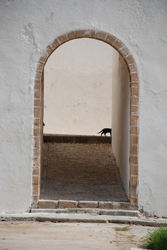
The ramparts gave us a view of the pottery workshops and kilns stretching down a green river valley.
We also had a view of the port and the town. As we rested in the shade of a large tree, the ticket guy came and said, "Isn't it magnificent!" We thought he was referring to the museum but he soon made it clear he was talking about the tree. It was a larch which casts a big shadow and, he said, whose sap kills mosquitoes. He asked if we'd been into the contemporary part of the museum which it turned out we had missed. It was a building created in more of an Andalusian style: decorated wood ceilings, ornate gesso work and a courtyard with a fountain. The rooms off the courtyard housed contemporary ceramics pieces in the Safi and Fes styles which were very ornate and elegant.
When we finished with the museum we decided to get lunch. Since Safi is a fish town we decided to find a fish restaurant. We found one off a small street in the market. A man stood in front frying various fish. We went in and asked for a menu but the waiter just ran off and brought bread. We asked for the price but he seemed to not understand. Now we really know better than to eat in a place in Morocco where they don't tell you the price but since everyone in Safi had been so nice and since local people were eating there we figured it was OK. The waiter brought us 2 little plates each, one containing calamari and one containing a couple pieces of fish and a few sardines. We started eating when a commotion broke out at the entrance. The 3 men who had been sitting near us were screaming at the restaurant owner about the bill. This was not a good sign since they were Moroccan. Again I tried to find the price but a local sitting next to me assured us it was small. We finished and Rowshan asked for the bill. It was 130 dh! (Usually our most expensive meals are half of that) So, Rowshan, taking a cue from the locals, started yelling at the owner until a crowd gathered and then he went off to find the police. A local who spoke English brought him back and the fight continued. The price went down to a more reasonable (but probably still too much) 70 dh. Rowshan kept arguing on principle but paid just as the police walked up. The police spoke English and were very polite. They took Rowshan off to the side and he explained what happened (mentioning that the guy had also overcharged 3 other customers). An onlooker tried to be diplomatic, saying "The price of fish varies day to day and today no one was working so no fish were caught. You are crazy eating fish today." Rowshan responded, "So that means this fish was caught yesterday!" The man repeated, "Yes, you are crazy eating fish today."
Since Rowshan had paid (the police asked if the price was acceptable), and the police had broken up the fight, there was nothing to do but walk off.
Anyhow, the situation spoiled our, "We love Safi!" mood and we went to a cafe (with a menu) for coffee and orange juice and to calm down. We determined that Safi was still a nice place but we just had the bad luck to deal with a couple of the town a-holes.
We walked down to a park overlooking the ocean and then around the city walls to the pottery workshops to visit Azzedine and Hameda. They ended up taking us to the Valley Alshe'be.
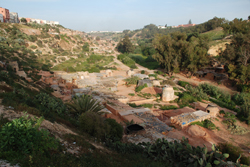
We walked through a residential area and Hameda said it was his neighborhood and proudly showed us a pretty park. As we were walking above the valley he got a call. "It is my uncle. He says he can see us and wants us to visit." We descended into the valley and went to a workshop where several rows of pots stood drying in the golden late afternoon sun.
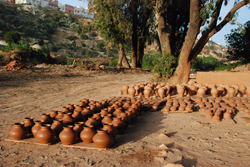
Inside the house a potter, Nurdin Asmid, was making tea pots. He was very kind and told us he can make around 50 teapots a day.
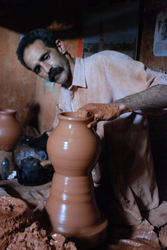
He worked, as the other potters of the town, by the light of the sun which shone in through the door of his workshop. Rowshan showed him his drums and heartily shook his clay covered hand when we left.
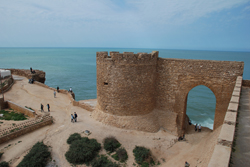
Hameda showed us the well on the upper level and piles of green glazed ceramic roof tiles, used on palaces all over Morocco. There were also bricks drying. As we left the valley we started talking about business possibilities: bringing tours from the States. Rowshan asked about the possibility of buying a building. We went back to Azzedine's shop and had pastries and cold drinks. Hameda started trying to teach me Arabic while Rowshan plied Azzedine and another guy for more ceramics info. The weather was beautiful and the flowers were blooming. We were back in love with Safi again.
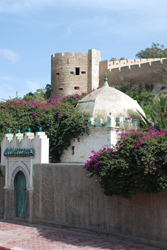
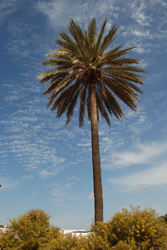
As we were hanging out with Azzedine, one of the potters Rowshan photographed asked for a copy of the photo. So we decided to print out copies for everyone.
Everyone seemed fairly pleased with their photos. Azzedine said people mailed photos but I'm guessing the photos aren't usually as nice as Rowshan's. After seeing the photos, more workers wanted Rowshan to take photos of them. Azzedine demonstrated how to make a tagine dish and a couple other pieces. He even attempted to teach me ceramics but I did not prove very adept at it.
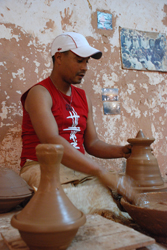
We are extremely thankful that we met Azzedine and Hameda. I was glad they liked hanging out with us because we really enjoyed the time we spent with them. Without Azzedine's introductions it would have been harder to develop the friendly rapport Rowshan had with the other potters. And it was really enjoyable sitting by Azzedine's shop, drinking mint tea and watching potters dip pots in kaolin or feed the kilns with the backdrop of the city walls, fortress, and mosques.
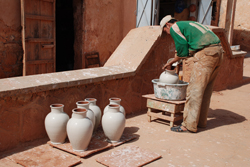
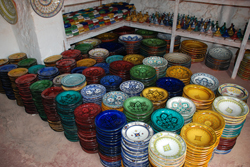
Since my French is so limited it was sometimes difficult to communicate but between our collective knowledge of bits of French, English, Spanish, and Arabic we got by.
Yesterday we took Azzedine and Hameda for lunch at Hosny's tagine place. Both, of course, knew him and Hameda said he was from his neighborhood. The tables in front of his place were full so he seated us in front of the shop next door, telling us to order drinks from there.
On our last day we visited the Chateau de Mer, a stone fortress on cliffs above the ocean.
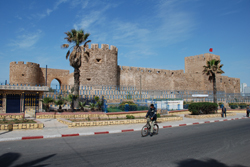
It is a tranquil place compared to the roar of cars zipping by and the street full of sellers. Inside we climbed the towers and enjoyed the view of the sea on one side and the town on the other.
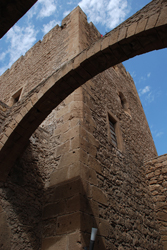

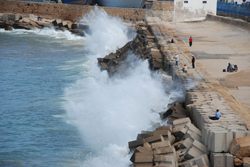
We were very sorry to leave Safi. In the few days we'd been there, we had met many kind people and made many friends. We were impressed by the skill of the potters there who are using techniques passed down through generations. Instead of needing tools for measuring pieces, they can create pieces of the correct size just by looking at them.
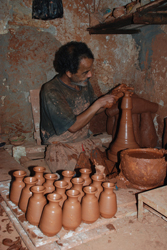
The town itself had a lot of beauty and was devoted to ceramics. Many tile paintings decorated the walls showing potters working or the kilns and workshops.
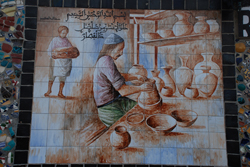
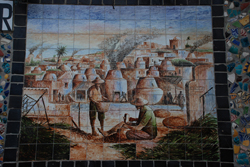
In other places walls were decorated with broken ceramics pieces
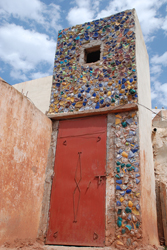
Rowshan was also happy to be in a place where when he said he was from Iran, many strangers would happily respond, "You are our brother!" because Iran is an Islamic country. But in reality, as he has found all over the world, the strongest sense of brotherhood has come from the potters and ceramics artists who are happy to share their art.
Call of the Sahara
14 March, 2008, 02:20 am in "Morocco"
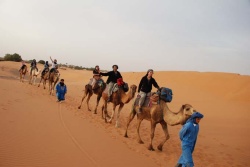 I asked our friend, Diane, who had lived in Morocco for a year, about places we should see. She answered that for her, "the essence of Morocco is found in the Sahara." First we said, "Some other time. We don't have time for it this trip." But the seed had been planted. Already images of golden sand dunes, the first scene from the movie The English Patient, Sheltering Sky, and Lawrence of Arabia began drifting through my mind. The thoughts were watered by gorgeous photos in the travel brochures and Diego talking about a tour to the Sahara he had taken from Marrakesh. It is a shame to go to Morocco and not see the Sahara. So before we even really got a look at Marrakesh, we booked a 3 day tour to the Sahara for the next morning.
I asked our friend, Diane, who had lived in Morocco for a year, about places we should see. She answered that for her, "the essence of Morocco is found in the Sahara." First we said, "Some other time. We don't have time for it this trip." But the seed had been planted. Already images of golden sand dunes, the first scene from the movie The English Patient, Sheltering Sky, and Lawrence of Arabia began drifting through my mind. The thoughts were watered by gorgeous photos in the travel brochures and Diego talking about a tour to the Sahara he had taken from Marrakesh. It is a shame to go to Morocco and not see the Sahara. So before we even really got a look at Marrakesh, we booked a 3 day tour to the Sahara for the next morning. Marrakesh isn't really close to the Sahara so the tour involved crossing the High Atlas Mountains, and then cruising along through semi-desert areas, oasis and river gorges. The tour covers a lot of space in 3 days so we moved at a quick pace.
First we climbed into the mountains which rise above Marrakesh, glistening white with snow.
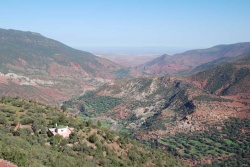
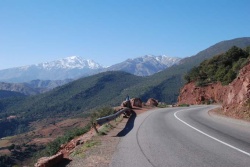
The Marrakesh side is green and has rivers and waterfalls. Then we descended to the drier side. The driver stopped a couple places to let us admire the view. However, the first long stop was lunch in the town of Ait Ben Haddou, famous for its Casbah.
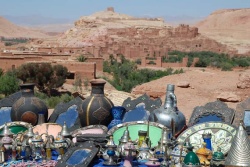
This side of the mountains revealed more of the Morocco I had imagined: red adobe houses rising up from the earth, some perched on the sides of hills, some looking like castles with majestic walls and decorations carved into their walls. Every village looked like a postcard with the Casbah framed by palms, sometimes with a river flowing at the foot of it.
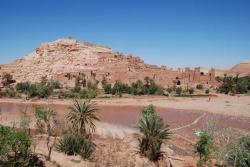
Storks build huge nests on the tops of the walls or minarets. The color of the earth is rich red vividly contrasting with the green of the oasis.
We cruised through Ouarzazate with a stop to take a quick look at the Casbah.
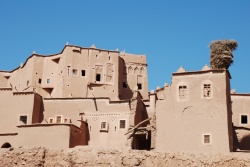
Next we went through the Valley of Roses.
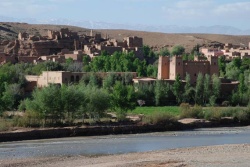
In Spring it is supposedly full of pink roses but perhaps we were too late or too early. Nevertheless, it was still a tempting and idyllic valley. The Gorge du Dades had walls made up of huge rock formations. Some resembled the pads of monkey feet while other parts looked like twisted rope.
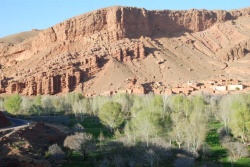
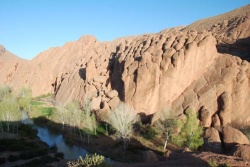
Through the gorge ran a small river lined with trees whose delicate leaves made them appear almost like a green mist. Occasionally a resident of one of the villages would pass by on a bike.
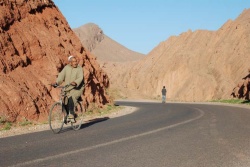
The road is definitely a tourist road and everywhere we stop, there are people selling geodes, ceramics, Berber clothing and colorful scarves. The later are hung so they blow seductively in the wind, bright splashes of color against the rocks.
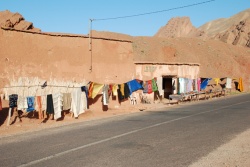
Our hotel for the first night was a pleasant surprise. It was in a gorge with high red cliffs dotted with caves sometimes used by Berbers.
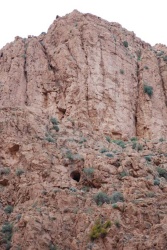
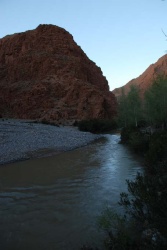
The rooms overlooked a soothing river. There were a few more hotels up the road but the area maintained a feeling of solitude and tranquility. Up the road, some of the building owners had created little models of mud houses, set in gardens.
We were back on the road at 8AM, retracing our path through the gorge. At a gas/toilet stop, which everyone also interpreted as a coffee stop, the driver scolded us for the delay saying we had to meet a guide who would be giving us a tour of a garden, Casbah, and Berber carpet maker's home. If we didn't hurry, we would be too late to ride camels.
The garden was actually a community field in a town called Tinerhir. It was criss-crossed by irrigation channels and raised paths.
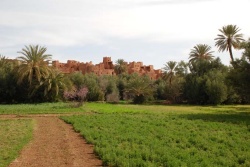
The fields were lush and verdant. Our guide, Hamid, led us through explaining that the women didn't like having their photos taken. We passed alfalfa and bean fields. The alfalfa was for the donkeys. There were also almond, peach and olive trees. Palm trees grew around the edges. Women in loose, traditional clothing bent down tending the fields or carried huge loads on their heads and shoulders down the path.
We picked up an entourage of local kids trying to sell camels made from woven palm leaves. One had tried to leave one on Rowshan's bag (after which a fee would be expected) and when we tossed it back at him, he ran off. Soon they returned to hover around other members of the group. We reached an area where the ruins of the Casbah rose above the fields. The adobe buildings had been destroyed 35 years ago by heavy rains. Our next stop was the newer Casbah known as the Jewish Casbah. It is now the summer home of Berber families who spend the winter with the animals in the mountains and then live in the town in the summer because the mountains are too hot and dry. Now, since the king is requiring education for all children, some of the women and all the children, spend most of the year in town. Tinerher looks like it is growing quickly and has some degree of prosperity. New concrete houses are being built along the main road imitating the style and lines of the adobe houses. The new concrete houses we passed were painted to resemble the red mud color of the traditional adobe.
We walked along the narrow mud streets to a little house where we were given a presentation about Berber carpets. Mohammad, the owner of the house, spoke English and gave us a short presentation about the Berber carpet tradition and how the carpets were made. His sister, demonstrated carding wool and spinning with a hand spindle.
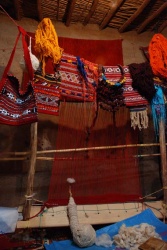
She used techniques she learned from her mother. The room was decorated with carpets on the walls and floor. We leaned against the walls as we sat on the floor. It was comfortable and cozy. Mohamed served tea as he pointed out the differences between carpets made from wool, camel hair and yucca fiber. The yucca fiber was a relatively new innovation for them, discovered by the women. It produced silky felling carpets. Camel wool was strongest. Some of the carpets combined techniques of weaving, knotting, and embroidery. He showed us a beautiful carpet woven by his mother and some of his sister's work. The colors were all from natural dyes and had different meanings.
Back outside, we worried that we were late and our driver would reprimand us. But, our guide said we had plenty of time. Our driver, however, hurried us into the minibus.
Our lunch stop was in the Gorges du Todra, a beautiful area where a tiny river ran between steep cliffs.
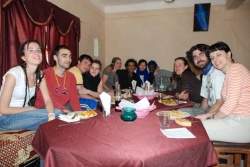
In one area the water was dammed to create a little turquoise pool crossed by a bridge. Further into the gorge, were rows of Berber stands with colorful scars floating in the breeze.
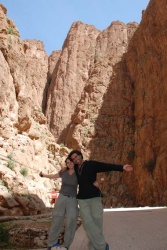
Rowshan has found that telling people he is from Iran gets an extremely positive result (unlike responses like, "Oh! Terrorist!" which he got in Peru). Although some of this because people don't realize that Iranians speak Farsi not Arabic, he is still able to joke with people and have more positive conversations than when he says he is from America. He also has been finding that the classical Arabic he was forced to study in school actually does have some use since he can pull out a word here and there and knows the grammar structure. I also think he manages to get quoted lower tourist prices than a more obviously Western tourist.
Back in the minibus, we drove constantly to reach the Sahara before dusk. We left the huge palm filled oasis and watched as the landscape became drier and plants smaller and sparser. Houses also became scarce except for occasional tourist facilities: cafes, gas stations, souvenir and ceramic shops, and an occasional sign for a hotel, usually also advertising camel treks. Occasionally we saw groups of camels.
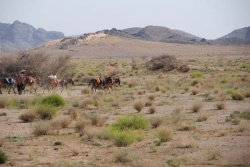
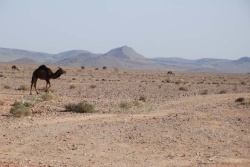
The weather was overcast but even so, we were able to see the dunes of the Sahara, pale orange through the haze, rising in the distance. The smooth curves of the dunes make a striking contrast against the rough rockiness of the surrounding area. They are huge and on a clear day their orange sands would have popped brilliantly against the blue sky. Even with a background of white clouds, one cant help but notice the beauty of their form, the grace of their lines and the shapes created by shadows.
We reached Merzuga close to sunset and quickly boarded our camels who waited behind a hotel, contentedly saddled up and seated on the ground chewing their cuds.
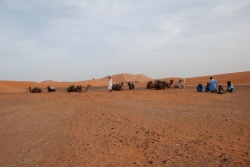
I was debating between one with a dark brown and white face and another beige one when the beige one winked at me (or more likely tried to clear some sand from his eye). So I chose him. His name was Zidane. Rowshan mounted the one behind me named, Jimmy Hendrix, and Isabelle, with a bit of trepidation, mounted a rather unhealthy looking ornery camel named Hergush, who had made a terrible camel grunt and protested greatly when he was forced to get up. Since the camels were tied close together, Rowshan spent much of the ride worried that Hergush would bite him from behind. Our group had 3 sets of camels, each led by young Berber men in traditional turbans, some in traditional robes as well. We slowly walked into the Sahara. Though we didn't have the majestic sunset of postcards, we still found ourselves in a beautiful mystical world of orange sands and quiet.
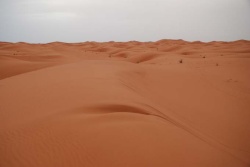
It took only a short walk to be out of view of the road, lights and towns. The shifting dunes towered above us. The breeze barely rippled the sands which shimmered as they shifted. Aside from the camel and human footprints, scarabs left sketchy little tracks through the sand often accompanied by a larger trail of a piece of camel feces which they rolled. The dunes stretched into the distance. They are hypnotizing and have a silent siren call which draws one in and makes one want to disappear into their sands... just keep riding or walking off into their soft silent landscape...
Well... the landscape was silent but the camels sure weren't. Midway through the trip, I heard a loud camel grunt and glanced back in time to see a slimy jet of mucus fly through the air and hit Rowshan. Hergush had strings of drool hanging from his mouth and had sent a gob of it onto Rowshan. A little while earlier, the camel had suddenly decided to take a rest and dropped down into the sand. Since our 3 camels were attached together, this pulled the rest of us to a stop and would have sent Isabelle tumbling if she hadn't been holding onto her saddle bars at that moment.
Eventually we reached a group of tents made from blankets, set up in a valley at the foot of a huge dune.
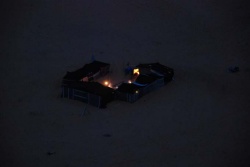
We dismounted and threw our bags (and shoes) in a tent and started walking up the dune. The sands are soft and it is difficult to walk following other tracks because you sink. We found if we walked on pristine sand, there was enough surface tension to sometimes keep us from sinking, at least until we reached the steeper area. Then it was necessary to push our feet deep into the sand to pull ourselves up the dune. The sun had set but the sky still held some light. About halfway up the dune I flopped down into the sand, exhausted. The sand was the softest sand I'd ever felt. It was still warm from the sun and I couldn't keep myself from lifting handful after handful and letting it run through my fingers. It is also unbelievably clean and I began to understand why the Sahara desert is considered a place of purification. I wanted to lie in the sand all night. I could feel the surface sands blowing lightly against my skin. There was a crescent moon which bathed everything in a ghostly light. Below in the camp, our guides had started drumming and singing. As it got darker, everything became shadows: the curves of the dunes against the sky, as well as the camels, other people, and a few stray bushes.
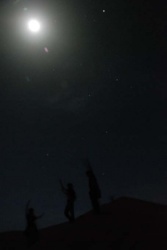
Turning and looking toward the top of the dune, the ridge was a dark path to the last blue of the west. Eventually I headed back down toward the camp, passing the dark shapes of others in our group who had succumbed to the magnetism of the sands and lay sunk into the dunes, staring at the sky.
Back in the camp, everyone sat on carpets around a couple small tables lit with candles stuck in sand filled water bottles. Our guides served tea and continued with their songs and drumming. Then a meal of chicken tagine was served, after which we had more music and danced a bit.
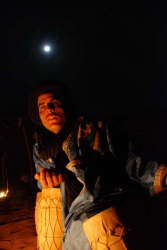
One of the guides proposed a hike to the top of the dune so we all began climbing again. This time we made it. Rowshan took a steep short cut to try to startle me by jumping out of the darkness making rabid sheep noises. At the top of the dune, we walked across a flat area to another small rise from where we could see the lights of Merzuga and other settlements and towns (one of which, the guide said, was the home of many Gnawa musicians). I turned to Rowshan and we agreed that we preferred the other direction with no lights except for the stars and the moon. Looking for some silence, we walked down a little ways and realized we weren't sure of the direction of the camp. Though it seemed obvious as we climbed, to return required guessing which of several ridges we had gone up since the camp was obscured from view. We realized how easy it would be to get completely lost in the dunes at night since walking a little in one direction could quickly hide any landmarks from view. The dunes were a subtle labyrinth, dangerous in their simplicity. We walked back up a little until we found the footprints of the group and got going in the right direction. Soon we were able to hear the drums of the camp and see the lights, so we sat down and enjoyed the peaceful night. The breeze had turned into a bit of a wind and the desert night was quickly cooling. The sand had also turned cold. We went back to camp where blankets had been spread in the tents for sleeping. It was a fairly comfortable night with a bed of sand and blankets, but we wanted to get up early for the sunrise. Everyone missed it because the day was overcast and so the sunrise was hidden. The guides saddled up the camels and we took a walk trying to soak up the desert before we had to leave. Rowshan spotting a lone camel in the distance, striking against the sands, set off in pursuit.
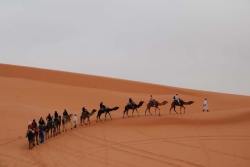
The camels were ready but Rowshan hadn't returned. I saw him off in the distance and called and waved for him to come back but he couldn't hear me and just waved back and continued walking in the opposite direction. Finally I had one of the guides wave to him so he got the message we were leaving. He got the message and began running. We got on our camels, leaving the sick one for Rowshan since he was late. I couldn't see Rowshan at all and started calling for him only to have one of the guides say, "He is right in front of you!" Sure enough, on the other side of the dune we were climbing, Rowshan sat gasping for breath. Hergush, the sick camel, seemed to be feeling a bit better. We speculated that maybe he had just been tired the night before or hated the desert so he was happy to be going back to town. It was a pretty trip back. The morning turned the sands golden. We chatted and laughed, bumping along on the backs of our camels.
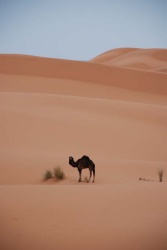
When we reached the hotel, we had a breakfast of tea, bread, and Moroccan pancakes, then got in the bus for the long road back.
[ View 1 Comments
|
]
Fes: Diving in the Medina
8 March, 2008, 06:55 am in "Morocco"
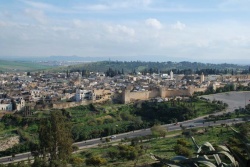 Descending into the medina fo Fes is a bit like SCUBA diving. You swim through crowds of people who make it difficult to move fast. You have to remember to breathe constantly. You see lots of interesting colorful things, but when you surface you really need to breathe real air and you feel completley exausted. That said, we managed to remain submerged in the medina a lot longer than we've ever remained underwater while diving.
Descending into the medina fo Fes is a bit like SCUBA diving. You swim through crowds of people who make it difficult to move fast. You have to remember to breathe constantly. You see lots of interesting colorful things, but when you surface you really need to breathe real air and you feel completley exausted. That said, we managed to remain submerged in the medina a lot longer than we've ever remained underwater while diving.Today we found Bab Bou Jeloud, the tourist gate. I don't know how we missed it last night since there was a row of busses parked outside it. Before we reached the gate we passed through a 2nd wall and gate where some men were busy repairing the stonework. It seems in a city like Fes, restoration workers would have a lot of job security.
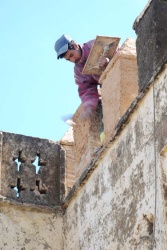
Bab Bou Jeloud is ornate with beautiful patterns carved into the ceramic tiles. One side was decorated with blue tiles while the other side was green.
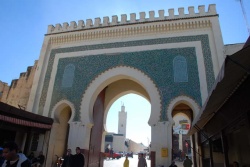
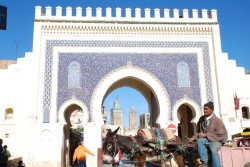
Cars aren't allowed (or maybe they just don't fit) in the medina, so the main form of cargo transportation is donkeys and mules. .
Once in the medina, we first came upon stone carvers working on gravestones for the cemetary, just outside the walls.
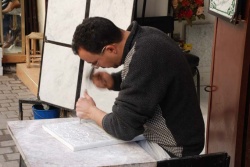
We mostly walked by the many shops but I couldn't resist ducking into one tailor selling women's kaftans. Although pretty, they were a bit pricey. A woman with beautifully hennaed hands was sitting talking to the seamstress. She let Rowshan take a photo of her hands but seemed to think he was nuts for taking it.
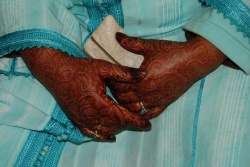
The medina is an interesting place. Some of the walls and buildings are plain and simple, then we'd come to a beautiful arch or ornate fountain where the handwork and craftsmanship involved was incredible.
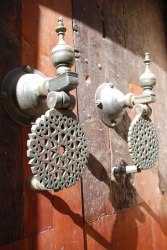
Some of the buildings with plain exteriors, had palacial interiors. A seemingly small antique shop we walked into opened up into huge rooms with elegant, high painted wood ceilings and decorated walls.
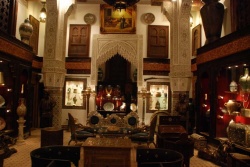
I love seeing places where handwork is so valued. We saw a wood worker, a metalsmith working on Moroccan lamps, a sliver smith making engraved “Damasc” pieces, and workshops where hand carved tables and shiny wedding sedan chairs were made.
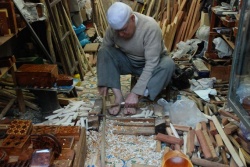
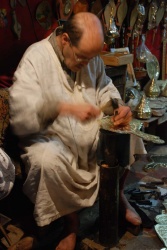
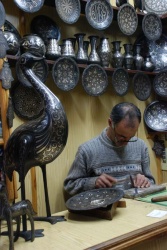
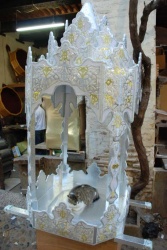
Though at first I felt flustered by the touts, eventually the sights and atmosphere began to work its spell and I became enchanted by all the fine works being created. I imagined a house with handcarved mother-of-pearl inlaid furnture, mosaic table tops and fountains, intricately painted ceramics and rich colored cushions and carpets. There were handmade dresses that looked like they belonged in a princess' wardrobe.
After a lunch of dubiously prepared but delicious sandwiches, we decided we needed to find a cafe. Then I saw Cafe Clock, which our friend Diane had reccommended. She had been friends with the owner, Mike, when she was living in Fes. We walked in and met Mike who turned out to have been the other foreigner with us on the bus from Chefchaouen. The cafe is in a beautiful space with a courtyard and roof terrace which lifts one above the chaotic medina streets.
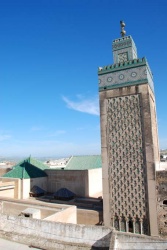
After resting, we walked around some more before surfacing at dusk to the mad circling of swallows in the rose tinted sky.
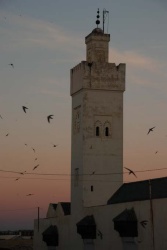
Rowshan has been having fun hanging out with some of the other guys staying in the hotel, and watching soccer games and music on the lobby TV. The guys told Rowshan where he could find the pottery workshops, so we took the bus there today. We were guided by a young man we met at the bus stop who turned out to be a potter, as well. The pottery neighborhood was located outside the walls in another part of the city. We went to a factory which was set up for tourists with a huge showroom and a multilingual guide/salesman.
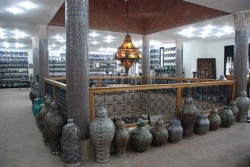
He was friendly and immediately took us back to a demonstration wheel where a potter quickly threw a piece and Rowshan got to stick his hands into clay and throw something as well. Our guide explained all the details Rowshan wanted to hear including where the clay came from and at what temperature it was fired. Then he took us into a workshop where a master and apprentice painter were working decorating pieces.
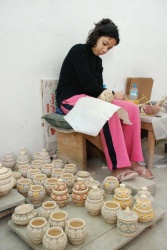
The mosaic makers and ceramic engravers weren't at work since it was Sunday, but our friend from the bus took us to another workshop and we got a demonstration of how detailed designs could be chipped into a ceramic piece solely using a large sharp-edged hammer.
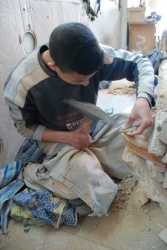
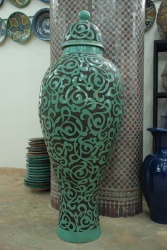
Our friend then took us back to the medina by a different gate and whisked us through the confusing streets until we reached the comforting color coded guide signs created by the city to keep tourists from getting lost.
Having had enough of the medina, we walked to the Borj Nord on a hill above the city. The area had parks, benches, lots of families, and groups of guys and girls enjoying the afternoon. We walked a bit farther to a ruined structure on another hill which was also covered with people.
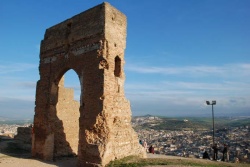
We walked up attracting a lot of attention, especially from the children who all called out, “Bonjour!” and found it very funny when we answered. As I sat on the grass admiring the view of the tranquil hills, fields and pastures on the side of the hill opposite the sprawling medina, a little boy came up to me and gave me a little bouquet of wild flowers, then ran off to some of the girls who'd been greeting me. I beckoned them over and shared some cinnamon candies I had with them. The'd come up to me, take a piece of candy and then run off.
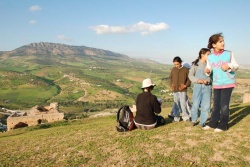
Meanwhile, Rowshan had joined me and was nearly trampled by a running donkey with young boys hanging off of it. He was taking pictures and the kids were having a great time posing and jumping on the poor donkey.
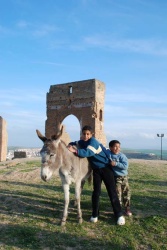
Then I saw him open his pocket revealing some change. The party was over. The donkey owner had demanded money and once the kids saw it was available they launched into cries of “Un dirham, monsieur! Un dirham!” We decided it was time to leave, saddened by how quickly something that was fun, enjoyable childrens' play avalanched into ceaseless begging. Though some of the kids stopped, a couple continued to follow. Some men, perhaps fathers or relatives, scolded the kids so they stopped for a minute only to continue once the men were out of sight. We fled down the hill.
The hill we walked down turned out to be the ruins of some tombs, now just caves. More fascinating was how tanners had covered the hillside with sheep skins to dry them in the sun.
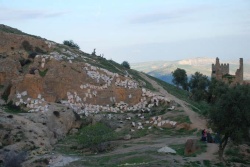
We walked back into town noticing how the ancient walls blended into a modern play field.
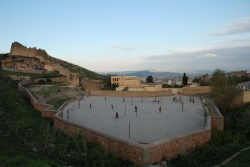
The main square was full of second-hand vendors and entertainers.
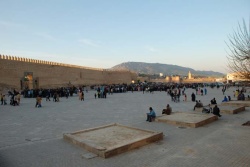
We took a quick look around then headed back to the New Town.
Our final day required an attempt at avoiding crowds and hawkers. So, we tried the “Palace's and Gardens” medina trail. This led us first to a palace which housed a small ethnographic museum. We started to walk through the gardens and ran into Diego, a Brazilian who like Rowshan and I lost/quit his job, sold his car, and is traveling around the world.
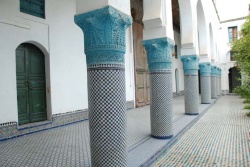
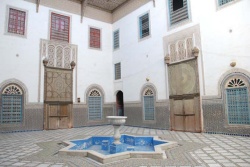
Rowshan met him the previous night at the hotel. We decided to try to find some lunch. A hawker led us to a restaurant promising “not expensive” prices. The place looked nice but when we asked to see a menu, he and the waiter insisted we sit down and kept repeating, “not expensive.” Rowshan and I started to walk out so the waiter ran and unlocked a cupboard from which he produced a menu. I glanced at a list of entrees with prices of 250 dh which is $30! I immediately walked out laughing. Diego followed quickly with the tout chasing us promising some dish for 60 dh.
Diego recommended a place in the Medina with 40dh dishes. It had a pretty terrace and the food was good. Finding ourselves, once again, in the busy part of the medina, we quickly got back on the green “gardens and palaces” trail which seemed more like a “dark abandoned street” trail. Eventually we did come to a palace which had been transformed into an institute for artisans to learn about traditional restoration techniques. The building was beautiful and there were some cluttered exhibits (or maybe just old projects being stored) including architectural models of historic areas, carved plaster work in progress and painted wood pieces. There was a window which opened out providing a view of the medina, and a peaceful garden.
Powered by My Blog 1.69. Copyright 2003-2006 FuzzyMonkey.net.
Created by the scripting wizards at FuzzyMonkey.net..
(Code modified by Rowshan Dowlatabadi)
Created by the scripting wizards at FuzzyMonkey.net..
(Code modified by Rowshan Dowlatabadi)

